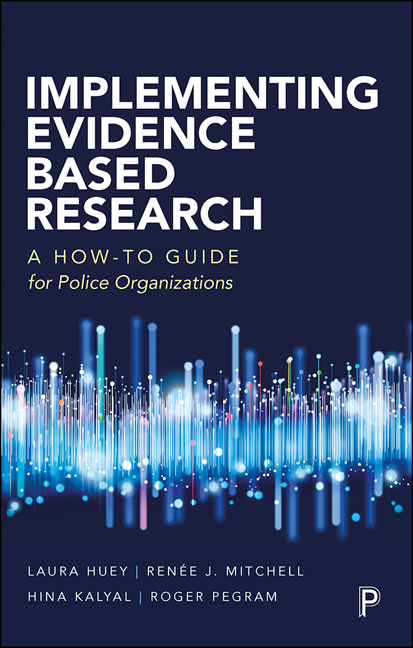Book contents
- Frontmatter
- Contents
- List of tables and figures
- Acknowledgments
- Introduction
- 1 Implementing evidence-based policing
- 2 Situating evidence-based policing
- 3 Understanding research
- 4 The individual approach
- 5 The smaller agency
- 6 The mid-sized agency
- 7 The larger agency
- 8 Generating sustainability
- 9 Resources for evidence-based practices
- Endnotes
- References
- Index
7 - The larger agency
Published online by Cambridge University Press: 05 January 2022
- Frontmatter
- Contents
- List of tables and figures
- Acknowledgments
- Introduction
- 1 Implementing evidence-based policing
- 2 Situating evidence-based policing
- 3 Understanding research
- 4 The individual approach
- 5 The smaller agency
- 6 The mid-sized agency
- 7 The larger agency
- 8 Generating sustainability
- 9 Resources for evidence-based practices
- Endnotes
- References
- Index
Summary
Throughout the early part of the 2010s, the City of New York, and New York Police Department (NYPD) in particular, were generating significant positive attention over the fact that the city's crime rate had dropped at about twice the national rate (Roeder et al, 2015). Heralded as the ‘New York Miracle’, commentators observed how the City that had formerly stood as a symbol for crime, social disorder, and urban decay was now the City that had become ‘safe’ (Zimring, 2013). Some have credited NYPD's use of Wilson and Kelling's (1982) ‘broken windows’ approach as generating declines in certain offences (Sengupta and Jantzen, 2018); others cite police use of the CompStat model to target district-level offences as the primary catalyst of change (Zimring, 2013). Regardless of what actually drove New York's crime decline, cities across the globe began to look to New York as offering potential solutions to adopt in response to their own local conditions.
That New York became a site from which other, frequently smaller, police services sought to poach crime fighting ideas is not surprising in one sense: larger police services often have the financial and human resources to develop and test their own innovations and/or to trial new technologies. To illustrate: the first major trial of body-worn cameras (BWCs) in the UK was with Devon and Cornwall Police, and the Toronto Police Service were the site of the first trial in Canada, both agencies with more than a couple of thousand sworn officers. Similarly, we find two other major municipal agencies – Los Angeles and Dallas – as two early adopters of predictive policing software. While larger agencies can clearly lead the way in trialling new innovations, we have to be careful not to draw too many conclusions from this. Access to significant resources – relative to other police services – does not automatically translate into a greater degree of innovation or an increased willingness to embrace change. Indeed, change in larger organizations can be long, slow, and difficult.
In the pages that follow, we argue the importance of laying a solid foundation for creating cultural change within larger police services. This can be done, we suggest, through identifying existing internal resources, as well as by creating new ones.
- Type
- Chapter
- Information
- Implementing Evidence Based ResearchA How-to Guide for Police Organizations, pp. 129 - 154Publisher: Bristol University PressPrint publication year: 2021



